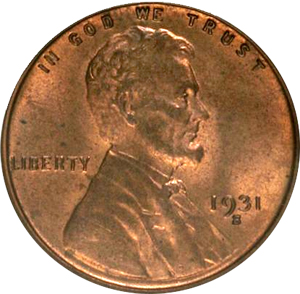By Dr. Sol Taylor
"Making Cents"
Saturday, August 4, 2007
| S |
|
The federal government also tightened its belt by closing many offices, laying off many workers, and putting a halt to many projects. In the early years of what became known as The Great Depression, the three United States Mints cut their operations dramatically.
For example, the largest Mint at Philadelphia limited its total annual output in 1931, 1932 and 1933 to the following: One cent: 1931, 19.3 million; 1932, 9 million; and 1933, 14.3 million — all far below any 10 years’ total before 1931. Five cents: None made in Philadelphia in 1931, 1932 or 1933. Dimes: 1931, 3.15 million; none made in 1932 or 1933. Quarters: None made in 1931 or 1933. The 1932 Washington bicentennial issue was 5.4 million. Half dollars and silver dollars: None made in 1931, 1932 or 1933.
The only gold coins minted in that three-year period were: 1932 $10 and 1933 $10 gold, and 1931 $20, 2.9 million — most were never released and are rare today; 1932 $20: 1.1 million (also msotly never released); and the famous 1933 $20, at least 13 known today (445,500 were manufactured but all were supposed to be melted).
At the Denver Mint in those years, production was limited to: Cents: 1931-D, 4.4 million; 1932-D, 10.5 million; and 1933-D, 6.2 million. Five cents: None minted in 1931, 1932 or 1933. Dimes: 1931-D, 1.2 million; none in 1932 or 1933. Quarters: 1932-D, 435,000; Half dollars and silver dollars: None minted in Denver in 1931, 1932 or 1933. Gold goins: $10, none minted in 1931, 1932 or 1933; $20 gold: 1931-D $20, 106,500 minted but mostly melted and never released; none minted in Denver in 1932 or 1933.
Coinage production at the smallest Mint, in San Francisco, was sharply curtailed with the following coinage production over the three years: Cents: 1931-S, 750,000 minted; none minted in 1932 or 1933. Five cents: 1931-S, 1.2 million; none in 1932 or 1933. Dimes: 1931-S, 1.8 million; none in 1932 or 1933. Quarters: 1932-S, 408,000; none issued in 1931 or 1933. Half dollars: 1933-S, 1.78 million; none minted in 1931 or 1932. No silver dollars were minted in 1931, 1932 or 1933. No gold coins were minted in San Francisco in 1931, 1932 or 1933. All of these Depression-era coins are worth a premium in all grades.
The 1931-S cent, while a very small mintage, was widely hoarded by investors or speculators, so today they are readily available in mint condition, although circulated specimens are hard to find.
In mint condition, all of the other coins are worth many times their face value, and some are worth thousands of dollars.
The gold coins were mostly recalled under the Gold Act of 1933 and melted. They are all listed as "rare" in standard coin catalogues.
As a youngster in New York during the Great Depression, my most commonly found coins were (in order of finds): 1931 cents, 1932 quarters, 1931-S nickels, 1933-S half dollars, 1931-S dimes and 1931-D cents. I don't recall finding any of the others (except gold coins, which never circulated).
In 1961, when I joined the Whittier (Calif.) Coin Club, I had a full roll of circulated 1931-S nickels, all found in change. I managed to get 25 to 75 cents each — a major profit at the time.
Other old-timers I knew had full rolls of the other dates, as well, but they started earlier than I did, and people such as Charles Ruby was a teacher who cashed his monthly paycheck for rolls of Brilliant Uncirculated coins from 1929 through the early 1940s. His hoard eventually brought more than $1 million some 30 years ago.
Dr. Sol Taylor of Sherman Oaks is president of the Society of Lincoln Cent Collectors and author of The Standard Guide to the Lincoln Cent. Click here for ordering information.
©2007 SCV COMMUNICATIONS GROUP & SOL TAYLOR · ALL RIGHTS RESERVED.

![[Most Recent Quotes from www.kitco.com]](http://www.kitconet.com/images/quotes_special.gif)

